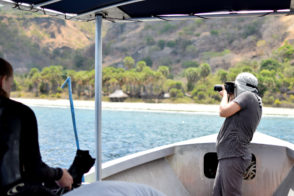Baleia is the Tetun word for whale
Despite the rush of sea spray and wind in my ears, I clearly hear somebody shout: “Blow, two o’clock!”. As one, we swivel around to spot the unmistakable spout of a pygmy blue whale a few hundred metres from the boat! It’s only ten minutes into our whale survey expedition in the azure waters of Timor-Leste and the early sighting sets the bar high for the day ahead.
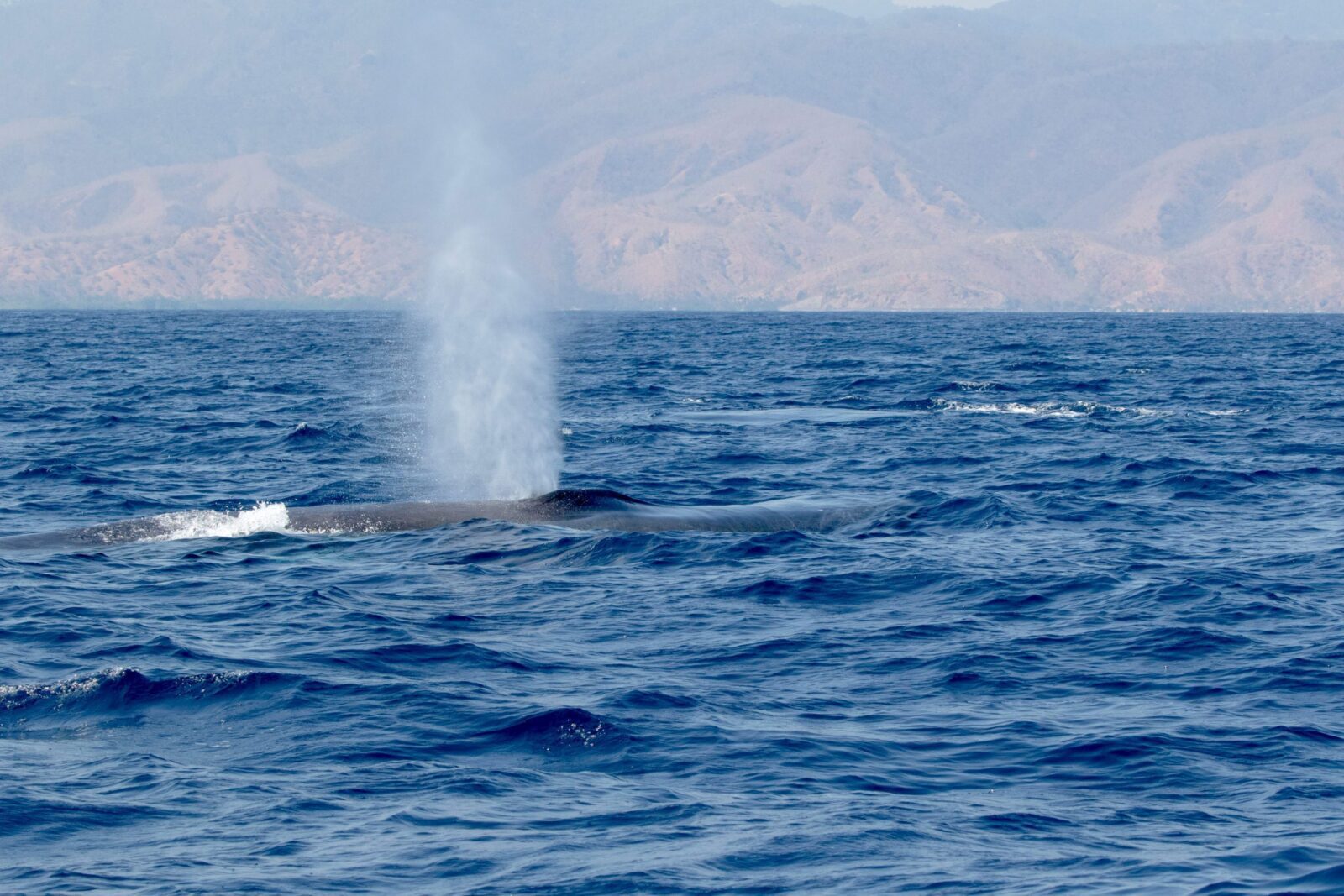
A pygmy blue whale spout, shooting high above the water | Photo: William Schrier
One of the world’s best kept secrets, the country of Timor-Leste has recently begun to attract global attention for its reputation as a whale-watching hotspot. Forming part of the Coral Triangle along with Indonesia, Malaysia, Papua New Guinea, the Philippines and the Solomon Islands, it’s home to around a third of the world’s 90 species of cetaceans (the group comprising whales and dolphins).
Whale expert Dr. Karen Edyvane from Charles Darwin University, Australia, strongly believes that Timor-Leste could develop sustainable cetacean tourism, provided there is a collaborative effort between local communities, dive operators, government bodies, and ecotourism organisations.
As part of her endeavour to bolster cetacean conservation efforts in the country and explore the potential for generating alternative livelihoods for local fishing communities, Karen studies the annual migration of pygmy blue whales (Balaenoptera musculus brevicauda) through the little-studied waters of Timor-Leste. This migration extends from approximately October to December, and we’re fortunate to have her join us as a scientific expert on our expeditions.
As a Field Scientist for Blue Ventures, an important part of my role is to deliver science dive training to the volunteers and conduct underwater surveys, which offers opportunities for some truly incredible dives. But the prospect of spending two weeks on an expedition focusing on cetaceans is exciting beyond belief!
On this expedition, we are joined by volunteers from all walks of life, most of whom have never encountered cetaceans before. Karen has already whetted the volunteers’ appetites with an introductory seminar, and on the morning of the first survey the excitement is palpable.
After only a few minutes into the survey, we’re treated to the rare sight of a mating pair of Olive Ridley sea turtles (Lepidochelys olivacea), soon followed by the towering spouts of a pygmy blue whale. These spouts can reach almost ten metres in height, last for a few seconds, and can be spotted from far away. Amid squeals of excitement, we decide to follow the whale (at a safe distance, of course).
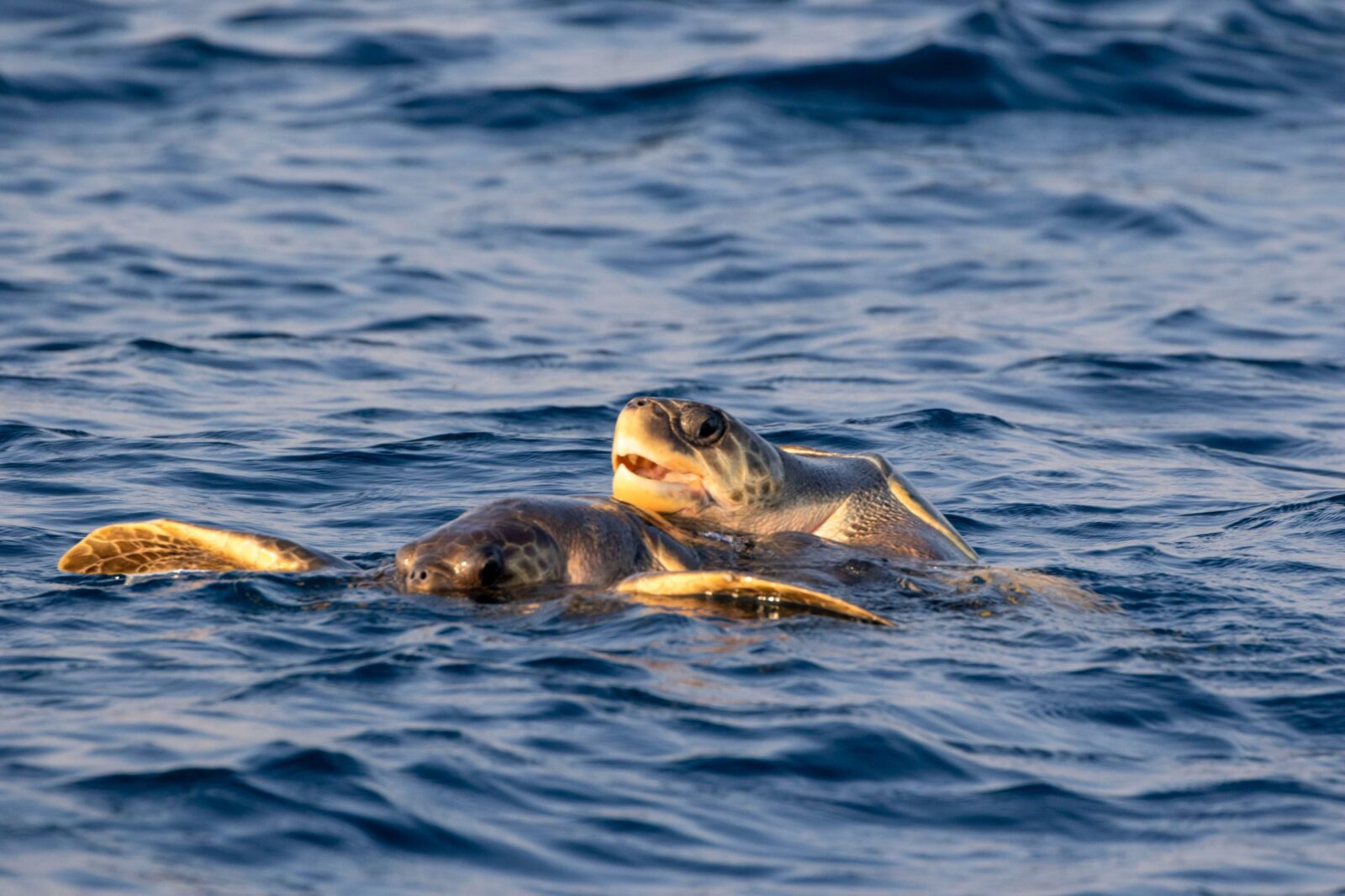
The pair of mating Olive Ridley sea turtles | Photo: William Schrier
However, nature has other plans in store for us. A pod of dwarf spinner dolphins (Stenella longirostris roseiventris) distracts us from our mission. Normally shy, they seem to have decided that we pose no threat, and they gleefully glide through the waters in front of the bow. Understandably, this prompts a mad dash for our cameras – there is a parallel display of human acrobatics as we look for the best position to photograph the pod. Insofar as cetacean surveys go, we’re having a cracker of a morning.
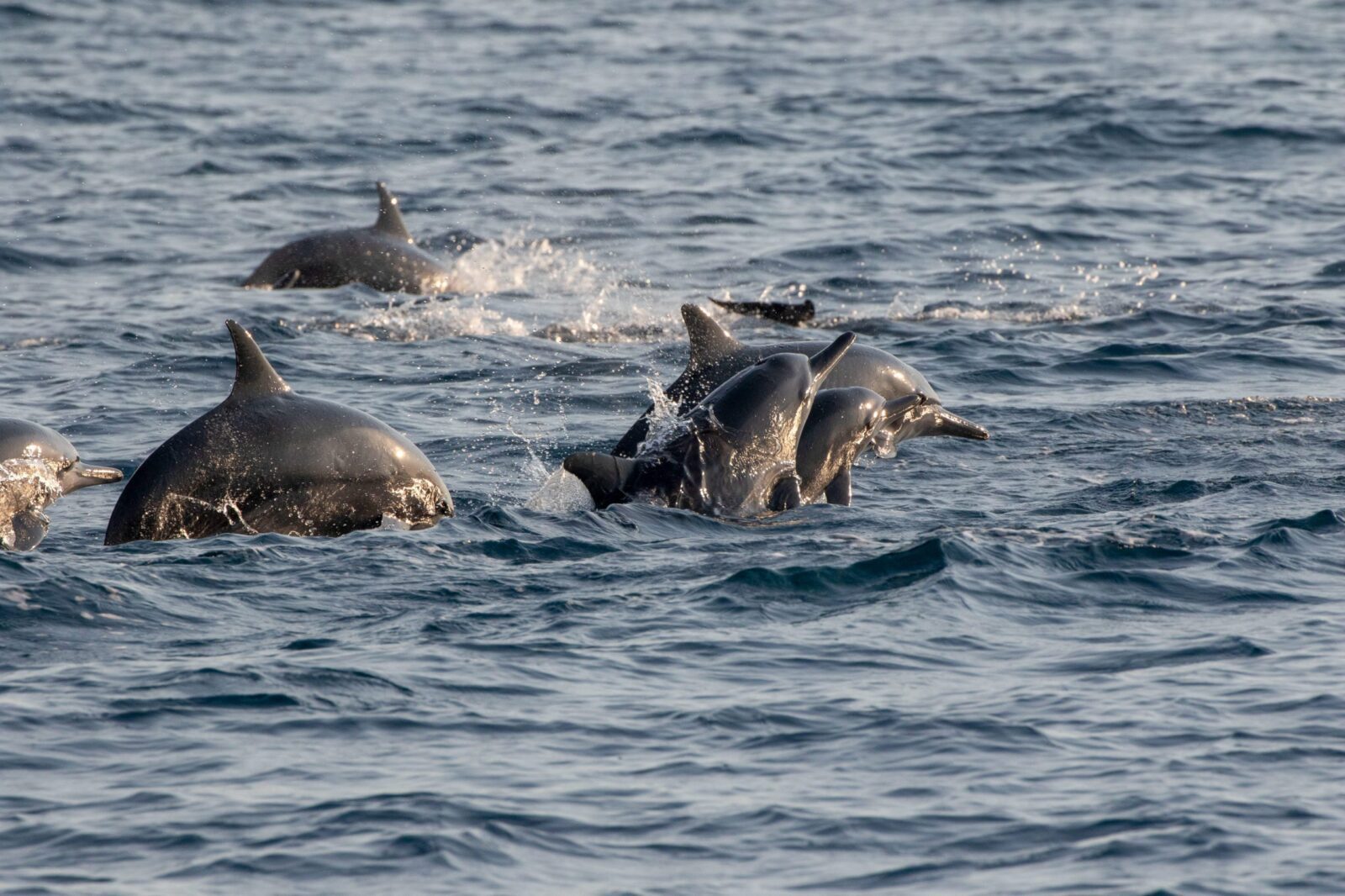
A pod of dolphins showing off their agility – it can be tricky to identify the species from above the water as Timor-Leste is home to several types of dolphin | Photo: William Schrier
It isn’t long before somebody spots another spout – and off we go again! This time we’re able to catch a glimpse of not one, but three whales! Cruising along at a nonchalant 6 knots, they seem unperturbed by our approach. Heading west along Dili’s coastline, they allow us to keep pace. We manage to get fairly close, but by crossing a certain invisible boundary we trigger a dive, and they disappear into the inky depths for a good twenty minutes at a time.
Each individual is massive (pygmy blues can get up to 24 metres long!) and can be identified by their dorsal fin. Our goal is to get as many photographs of these fins as possible to create a photo library, which can be used to monitor individuals over the years. The whales sometimes tantalise us, breaking the surface with their grey-blue mottled skin (which gives them their name) and going under again without a dorsal fin display. We are not to be deterred, however, and after an hour and a half with these gentle giants we capture some excellent fin shots. Karen is delighted. As a final treat, one of the whales flukes, showing us its magnificent tail fin, before diving into the deep.

A pygmy blue whale’s grey-blue mottled back, breaking through the surface | Photo: William Schrier
We return to land feeling jubilant. But the two-week expedition has only just begun. From Dili we head to Atauro Island, our home for the next ten days. The calm waters allow for some truly spectacular sightings of short-finned pilot whales (Globicephala macrorhynchus), which, despite the misleading name, are actually a kind of dolphin. Around sixty of them surround our little boat, their characteristic sickle-shaped dorsal fins breaking the water’s surface every so often. They urge us in the direction of Beloi, giving us company for a while before our boat outstrips them. It is at Beloi that we will be based for the remainder of the expedition.
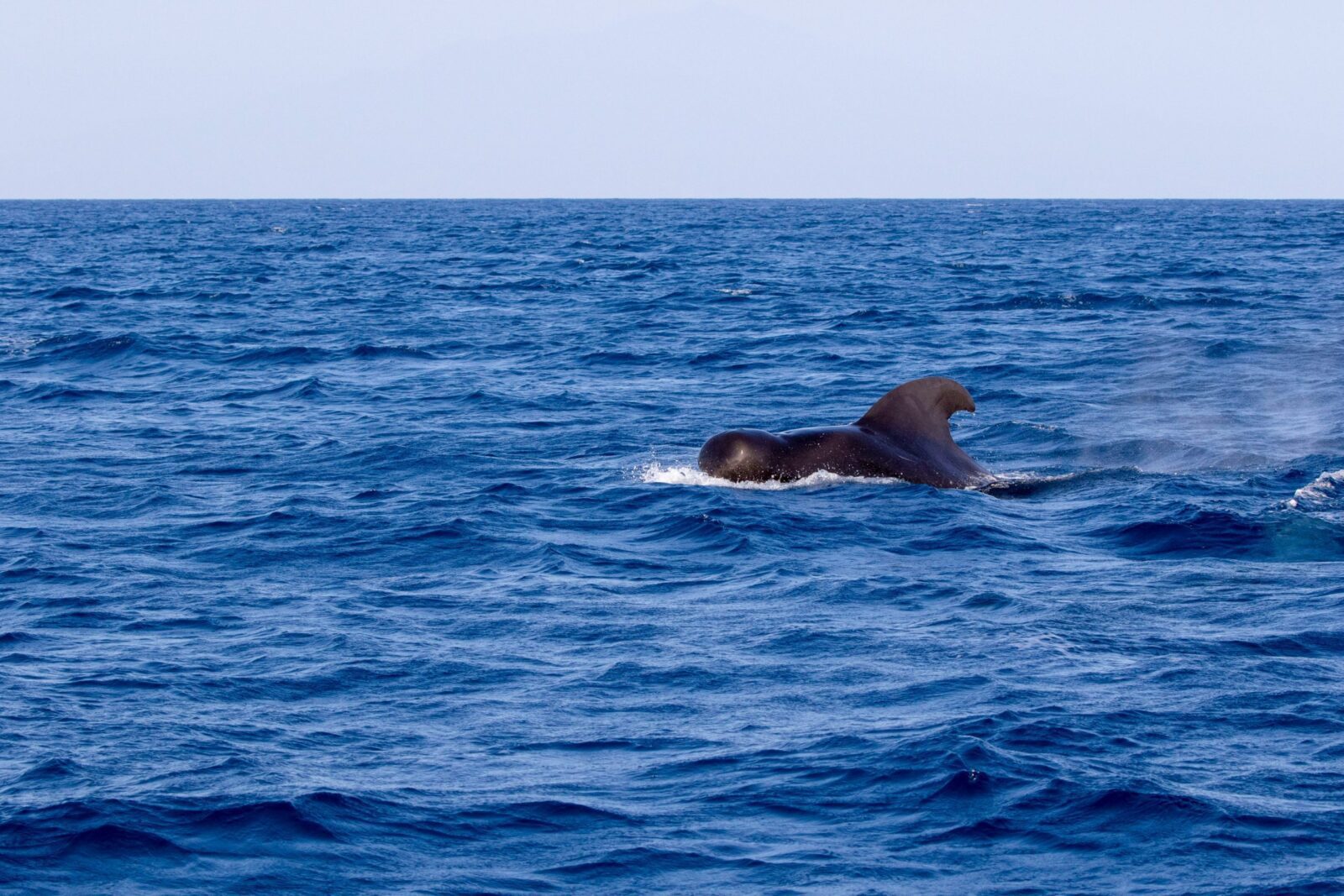
A short-finned pilot whale, not to be mistaken for a melon-headed whale despite their rotund head shape! | Photo: William Schrier
The expedition passes by in a blur of activity. In just two weeks the volunteers complete their scientific dive training and can now conduct Reef CheckTM surveys (benthic and fish); we navigate around the island to Adara on the western coast where they dive an almost-vertical wall drop-off, and spend the night under the stars. In Biqueli they witness and participate in the making of traditional seaweed cakes, and head to the neighbouring village of Vila to explore their unique doll factory, Boneca de Ataúro. In partnership with local organisation Ekipa Tasi Mos, we have arranged a beach clean and volunteers learn to categorise collected rubbish in accordance with guidelines from Tangaroa Blue.
Towards the end of the volunteers’ stay, we facilitate a Community Based Cetacean Tourism workshop, involving several representatives from the local communities on Atauro. The aim of the workshop is to provide a platform for communities to voice their opinion on the merits and demerits of promoting whale-watching tourism. The community members are animated and full of suggestions, and Karen enthusiastically notes these down for future use.
All too soon, it’s time to bid farewell to the island. Crossing the channel from Beloi to Dili proves to be quite eventful, and some melon-headed whales (Peponocephala electra – also dolphins) form a farewell party for the volunteers. By now, the volunteers are confident in their identification, and there are congratulatory pats on the back as everybody determines the species they see around the boat. It seems that Karen has done her job well.
People are in high spirits – they have seen the largest animal on Earth, dived alongside some incredible marine wildlife while simultaneously collecting valuable scientific data, learned from some of the Timorese communities on Atauro, and all in all had a rollicking time. Just as the blue whales continue southwards on their migratory route, the volunteers begin their own journeys back home, carrying a little bit of paradise in their hearts.
Don’t miss your chance at seeing some of this incredible marine life and join us on an expedition in Timor-Leste
Explore our photo story for more breathtaking shots of Timor-Leste’s magnificent cetacean population
Blue Ventures would like to thank our supporters and funders including the Darwin Initiative through UK Government funding.






